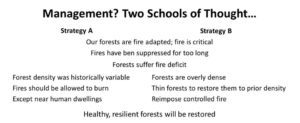How should we manage our forests?
One slide that I didn’t present due to lack of time (my fault, I know) was the following, which identifies the two prevailing schools of thought regarding SW Oregon forest management that don’t focus on timber harvest as our goal but rather seek healthy resilient forests.

Acknowledge, please, that this is a gross simplification, and many nuances exist that are not indicated. However, one can see that both start and end in basically the same place.
Note that both approaches start and end in the same place. Both accept the historically important role of fire, and both seek heathy resilient forests. Strategy B is probably best represented by the Ashland Forest Resiliency Plan which seeks to restore the health of the forests of the Ashland watershed. The argument here, which we hear often, and seems a reasonable con sequence of the successful (devastating) imposition of fire suppression in the 1930s or so, is that fire suppression has allowed the invasion of fire sensitive, shade tolerant species (Douglas fir especially) and our forests are now overly dense. The build-up of fuel, it is argued, leads to more severe fires (when they occur). The best way to reduce fire severity, then, is to thin the forest mechanically, and allow controlled burns to be re-imposed. This approach is consistent with much of the western forest management literature.
Strategy A is based on the argument that forests were historically of variable density, and that higher density did not result in greater fire risk or severity. The essence of this argument is that because even apparently serious fires are patchy and a very small percentage of the area actually suffers very severe damage, we should allow fires to burn whenever possible (though imposing as much control as we can) while focusing our attention on protecting human dwellings and infrastructure through ‘defensible space’ and focused fire management when it occurs.
Both approaches, it can be seen, recognize the importance of fire for the health of the system and urge its maintenance (A) or re-imposition though under controlled conditions (B).
One problem with both approaches, however, is that they seem to assume we have solved the global warming / climate change problem. This means they assume climatic conditions have not shifted such that current species are no longer viable. But, what if regrowth following wildland fires result in chaparral scrub rather than regrowth of healthy Douglas fir forests. Recall, that Douglas firs are only as abundant as they are today because of prior (pre-settler) climate change and fire suppression. Our memories are only as long as our lives – and even local ‘old-timers’ only know fire suppressed communities, so think the cathedral forest of Douglas fir is the native community when probably it’s a much more open Ponderosa pine.
And then, add the wrinkle that from the carbon sequestration point of view, Douglas fir is much better than Ponderosa pine….

